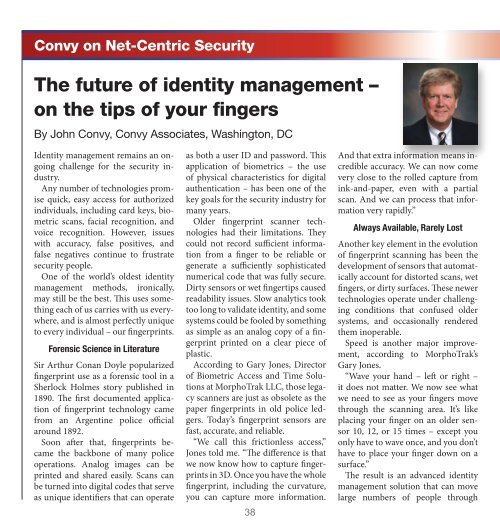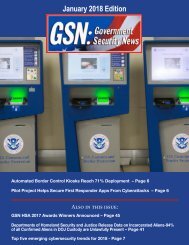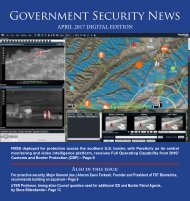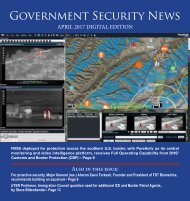GSN_Oct_YUMPU
Create successful ePaper yourself
Turn your PDF publications into a flip-book with our unique Google optimized e-Paper software.
Convy on Net-Centric Security<br />
The future of identity management –<br />
on the tips of your fingers<br />
By John Convy, Convy Associates, Washington, DC<br />
Identity management remains an ongoing<br />
challenge for the security industry.<br />
Any number of technologies promise<br />
quick, easy access for authorized<br />
individuals, including card keys, biometric<br />
scans, facial recognition, and<br />
voice recognition. However, issues<br />
with accuracy, false positives, and<br />
false negatives continue to frustrate<br />
security people.<br />
One of the world’s oldest identity<br />
management methods, ironically,<br />
may still be the best. This uses something<br />
each of us carries with us everywhere,<br />
and is almost perfectly unique<br />
to every individual – our fingerprints.<br />
Forensic Science in Literature<br />
Sir Arthur Conan Doyle popularized<br />
fingerprint use as a forensic tool in a<br />
Sherlock Holmes story published in<br />
1890. The first documented application<br />
of fingerprint technology came<br />
from an Argentine police official<br />
around 1892.<br />
Soon after that, fingerprints became<br />
the backbone of many police<br />
operations. Analog images can be<br />
printed and shared easily. Scans can<br />
be turned into digital codes that serve<br />
as unique identifiers that can operate<br />
as both a user ID and password. This<br />
application of biometrics – the use<br />
of physical characteristics for digital<br />
authentication – has been one of the<br />
key goals for the security industry for<br />
many years.<br />
Older fingerprint scanner technologies<br />
had their limitations. They<br />
could not record sufficient information<br />
from a finger to be reliable or<br />
generate a sufficiently sophisticated<br />
numerical code that was fully secure.<br />
Dirty sensors or wet fingertips caused<br />
readability issues. Slow analytics took<br />
too long to validate identity, and some<br />
systems could be fooled by something<br />
as simple as an analog copy of a fingerprint<br />
printed on a clear piece of<br />
plastic.<br />
According to Gary Jones, Director<br />
of Biometric Access and Time Solutions<br />
at MorphoTrak LLC, those legacy<br />
scanners are just as obsolete as the<br />
paper fingerprints in old police ledgers.<br />
Today’s fingerprint sensors are<br />
fast, accurate, and reliable.<br />
“We call this frictionless access,”<br />
Jones told me. “The difference is that<br />
we now know how to capture fingerprints<br />
in 3D. Once you have the whole<br />
fingerprint, including the curvature,<br />
you can capture more information.<br />
38<br />
And that extra information means incredible<br />
accuracy. We can now come<br />
very close to the rolled capture from<br />
ink-and-paper, even with a partial<br />
scan. And we can process that information<br />
very rapidly.”<br />
Always Available, Rarely Lost<br />
Another key element in the evolution<br />
of fingerprint scanning has been the<br />
development of sensors that automatically<br />
account for distorted scans, wet<br />
fingers, or dirty surfaces. These newer<br />
technologies operate under challenging<br />
conditions that confused older<br />
systems, and occasionally rendered<br />
them inoperable.<br />
Speed is another major improvement,<br />
according to MorphoTrak’s<br />
Gary Jones.<br />
“Wave your hand – left or right –<br />
it does not matter. We now see what<br />
we need to see as your fingers move<br />
through the scanning area. It’s like<br />
placing your finger on an older sensor<br />
10, 12, or 15 times – except you<br />
only have to wave once, and you don’t<br />
have to place your finger down on a<br />
surface.”<br />
The result is an advanced identity<br />
management solution that can move<br />
large numbers of people through















